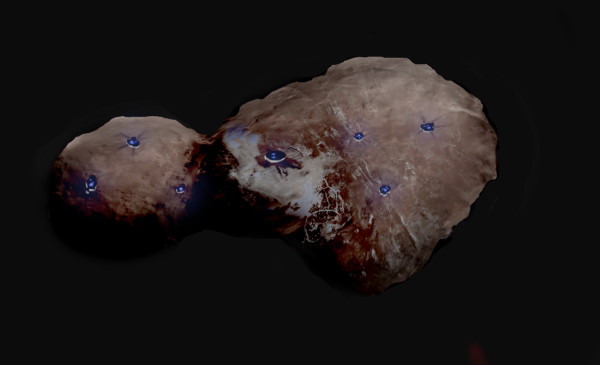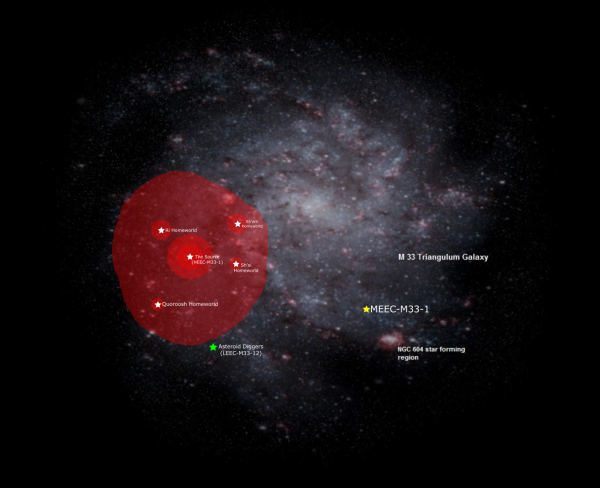BY LETTER
Asteroid Digger Civilisation
A Xenosophont civilisation in M33, the Triangulum galaxy | |
 Image from Steve Bowers | |
| A modified asteroid from the Asteroid Digger civilization. This civilisation has been detected at long range using the Argus Array and other, associated telescopic systems | |
The Asteroid Diggers | |
| Location | M33, the Triangulum galaxy Spiral Arm IS/1B |
|---|---|
| Distance from Milky Way | 2.7 megalightyears |
| Catalog of Xenosophont Civilisation no: | LEEC-M33-12 |
Also located in M33 at this time was the large and complex civilisation known to Terragen astronomers as the Source, since it was the origin of the Triangulum Transmission; it is essential to recognise that all these events occurred more than 2.7 million years ago, because of the time taken for the light to reach the Terragen Sphere. The territory of the Source civilisation appeared to be expanding, and its edge began to inch closer to the (apparently dead) system over time. Unexpectedly, in the 8000s, several other locations in the surrounding volume of space around this system (with a radius of roughly 10 light years) began to show signs of sophont activity.
At first, the signs were subtle: specific rocky asteroids in asteroid belts started to eject material to redirect their orbits to pass other similar asteroids more often, events that occured with such frequency that they could not be explained by natural phenomena. In the brief moment an asteroid passed next to another, Terragens were able to detect (through spectrographic analysis) the exchange of dust made of various compounds used in cryochemical reactions. Starting in the 8500s AT, some asteroids began to develop deep holes in which optical phased-array transceivers were constructed. These holes were the origin of the name given to this civilisation, the Asteroid Diggers. The transceivers appeared to be optimised to minimise stray thermal and electromagnetic emissions, which made observation harder than expected.
The emissions from these transceivers showed some similarities to equivalent devices used by the Source civilisation, suggesting a reverse-engineering effort. Terragen astronomers were able to detect brief (and very rare) images of various types of mobile entities on the surface of these asteroids; they were difficult to detect at this distance, but appeared to resemble crystalline caterpillars or worms, but due to resolution limits of the Argus Array this comparison is problematic. The Asteroid Diggers observed in different systems have shown considerable variation in size and color, but all seem to have followed the same basic bodyplan.
The actual nature and history of the Asteroid Diggers remains a point of dispute. Some believe that they were the highly modified descendants of bionts that fled their homeworld after the disaster. Others believe that they were instead vecs or the remote drones of artificially intelligent entities that somehow escaped the cataclysm. In face of the available evidence, either option is considered likely by many respected xenologists, and most agree that their observed behavior showed parallels to the ahuman AIs of the Diamond Belt and other hider groups in Terragen space.
 Image from MiyuwiAuthor and Steve Bowers | |
| The Triangulum Galaxy, showing the relationship between the Source Civilisation and the Asteroid Diggers | |
Nevertheless, by the 9600s AT an agreement was apparently reached, and all factions stopped launching asteroids at each other. While they previously showed an obvious lack of interstellar-scale coordination, the resolution of the conflict led the Asteroid Diggers to become able to organize themselves into becoming a true interstellar civilization. It is unclear if the Source had a role in this development.
Trends of accelerating technological advances and engineering efforts began to be observed propagating through their systems at the speed of light. In the Current Era this trend accelerated greatly, almost as if the Asteroid Diggers were in a hurry to catch up to the Source's level as soon as possible, because the edge of the Source's territory was observed to be little more than one hundred light years away from the closest Asteroid Diggers' system.
Given the obvious gap between both civilizations, the eventual outcome cannot be predicted. In some systems craft resembling small worldships have been sighted. Observers await to see whether the Asteroid Diggers join the Source's civilization as it expands or if the worldships represent a means of escape.
Related Articles
Appears in Topics
Development Notes
Text by Rakuen07
Initially published on 25 September 2024.
Initially published on 25 September 2024.






